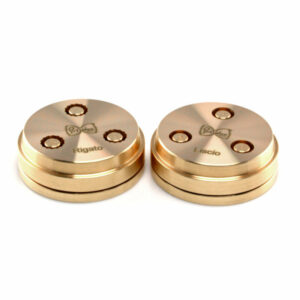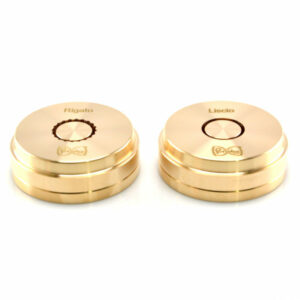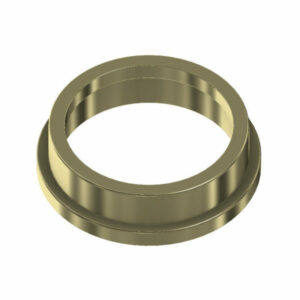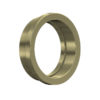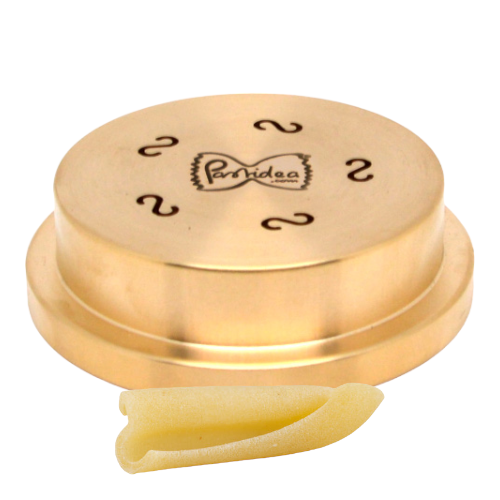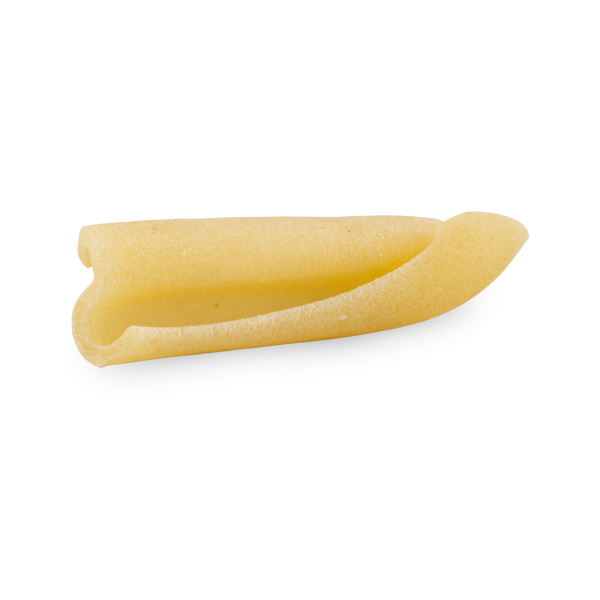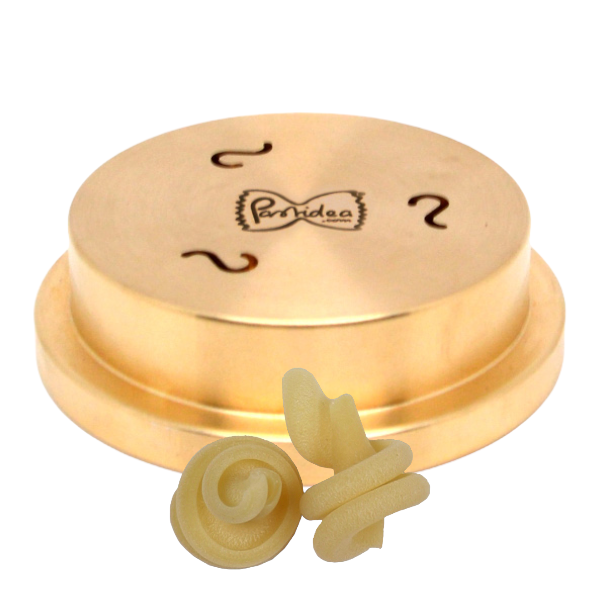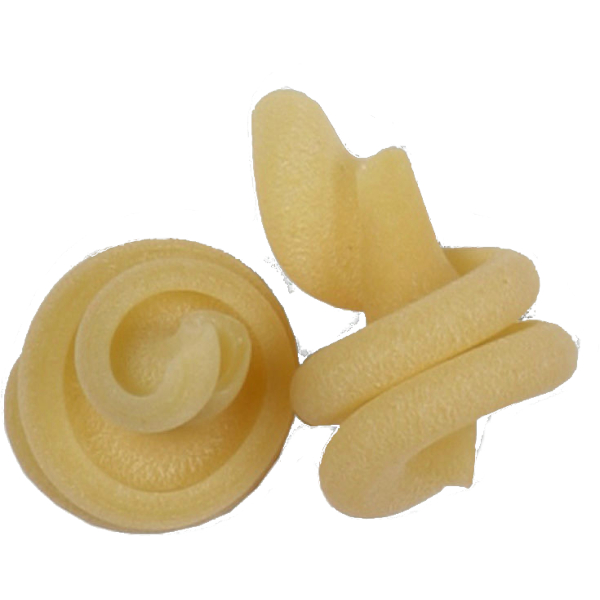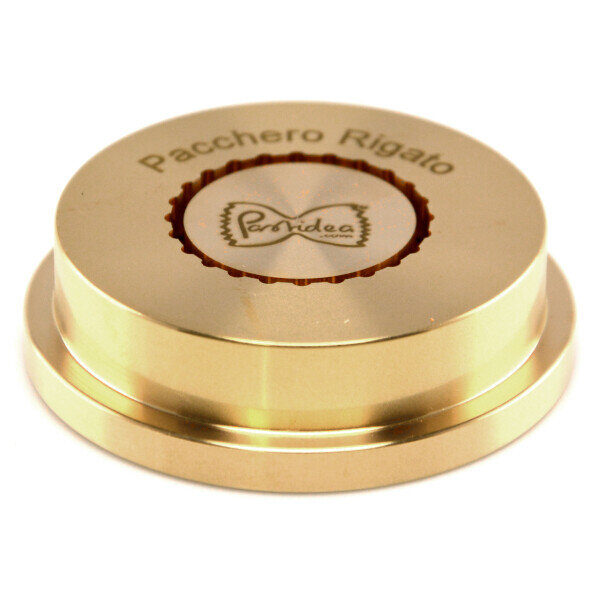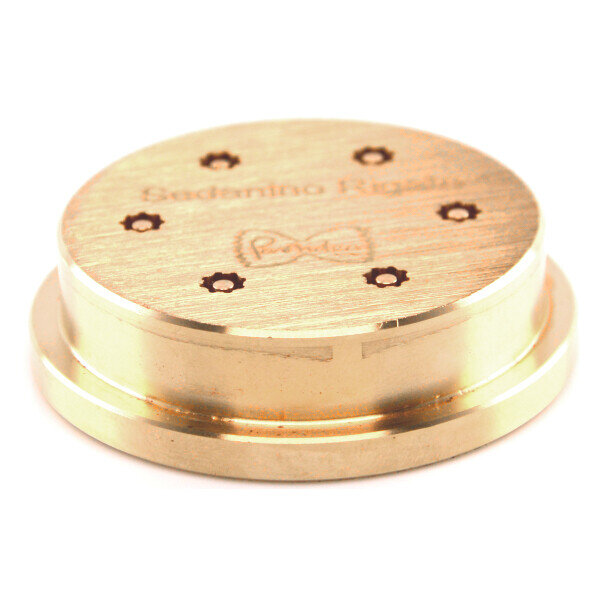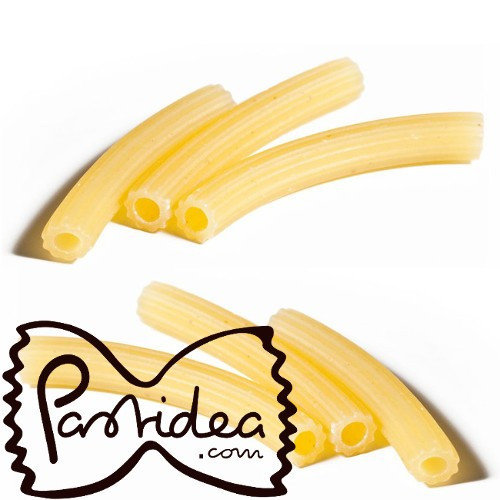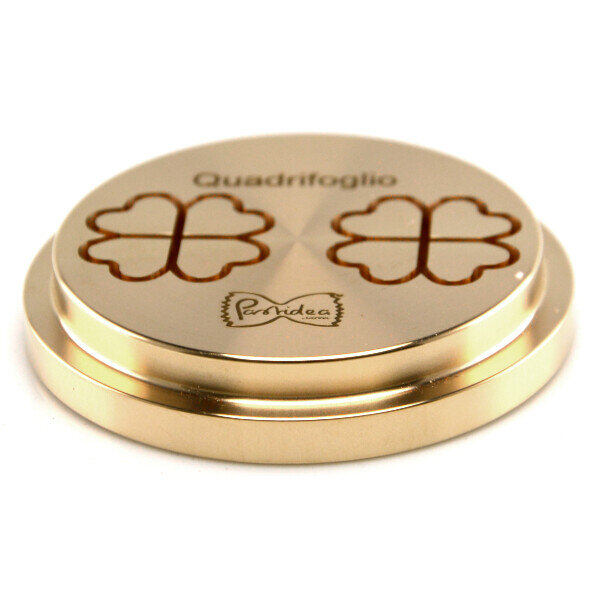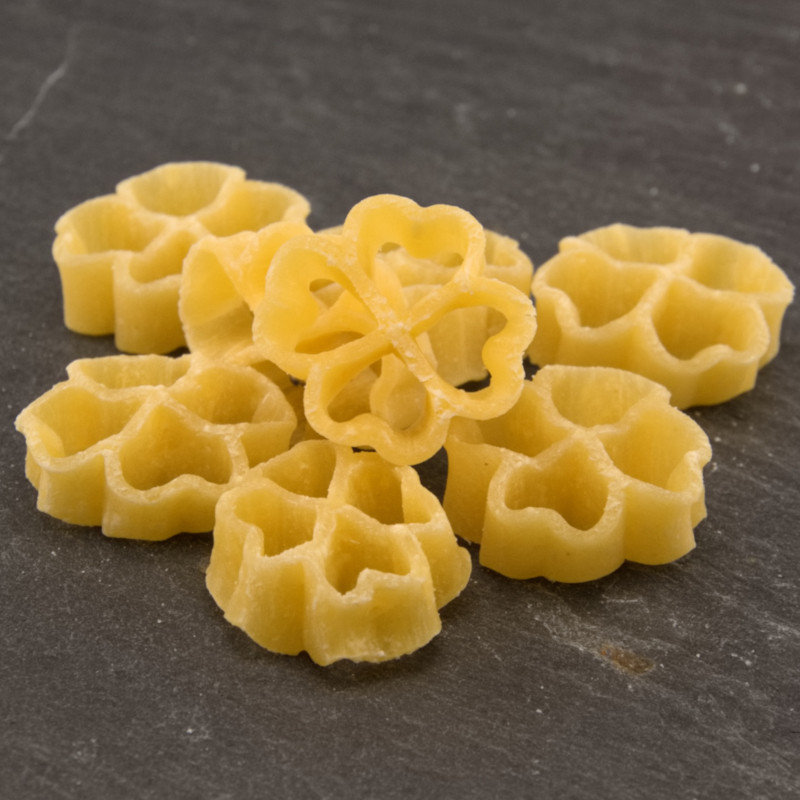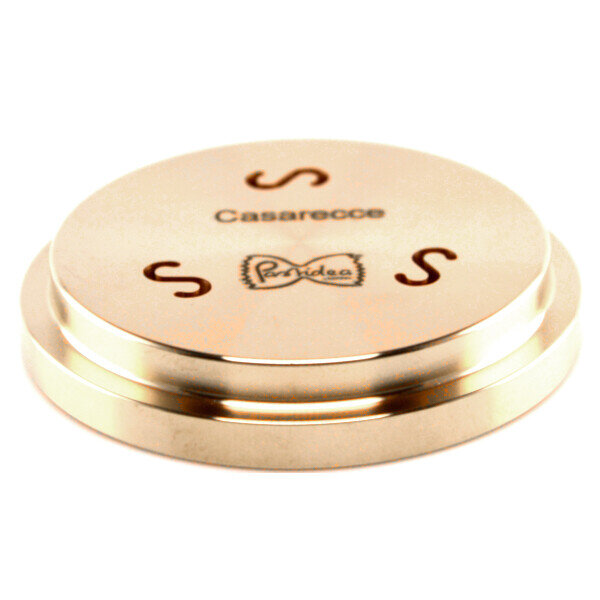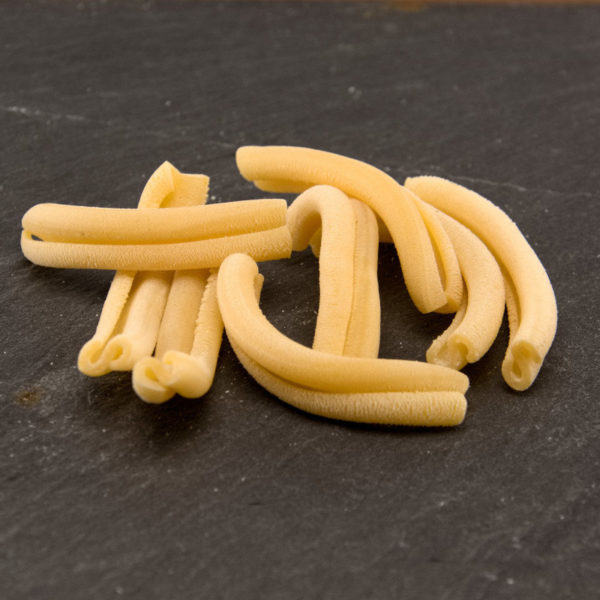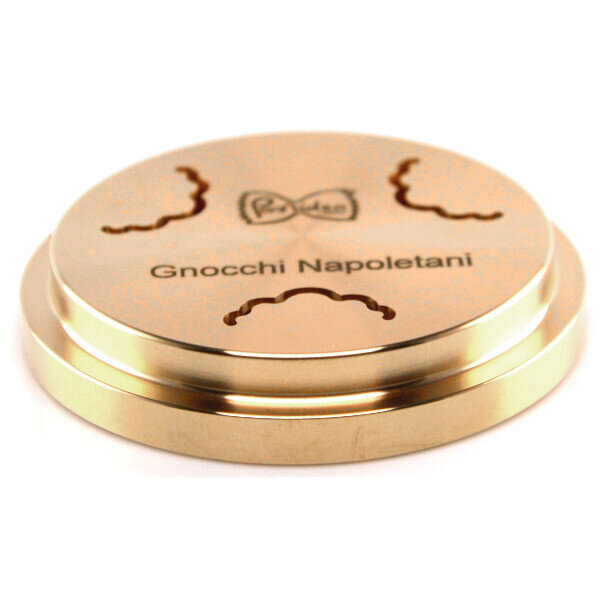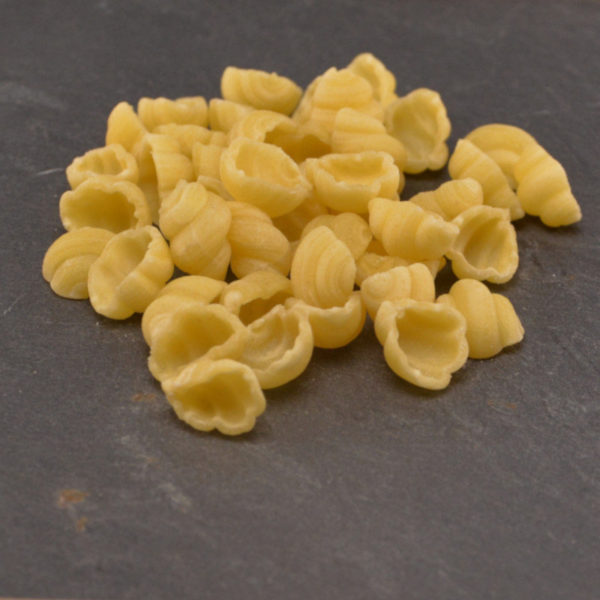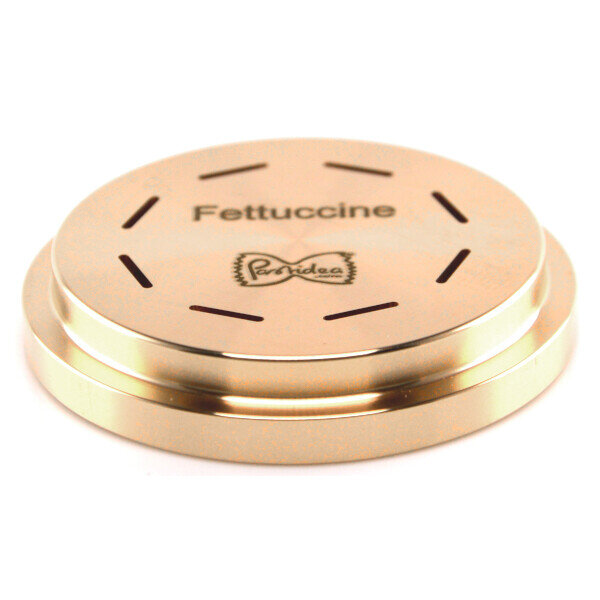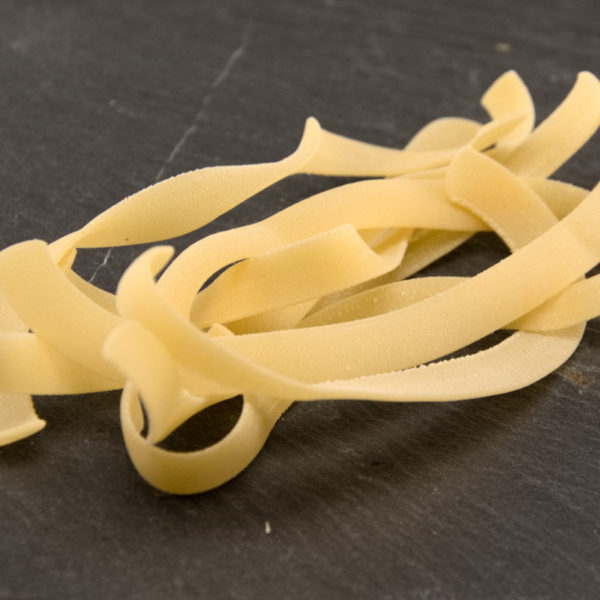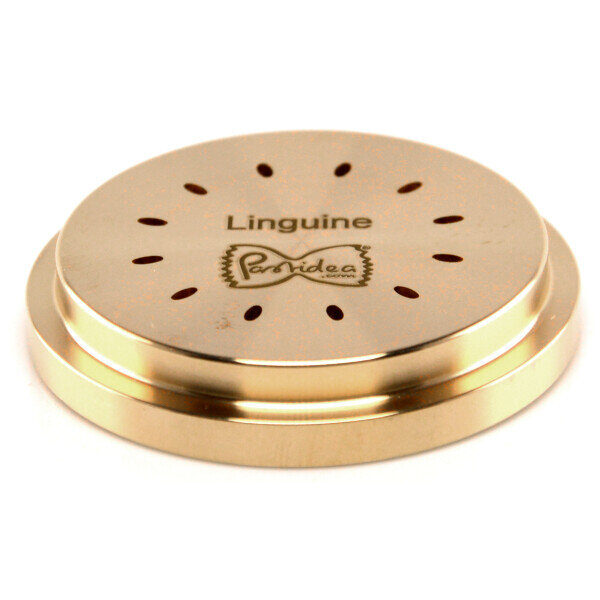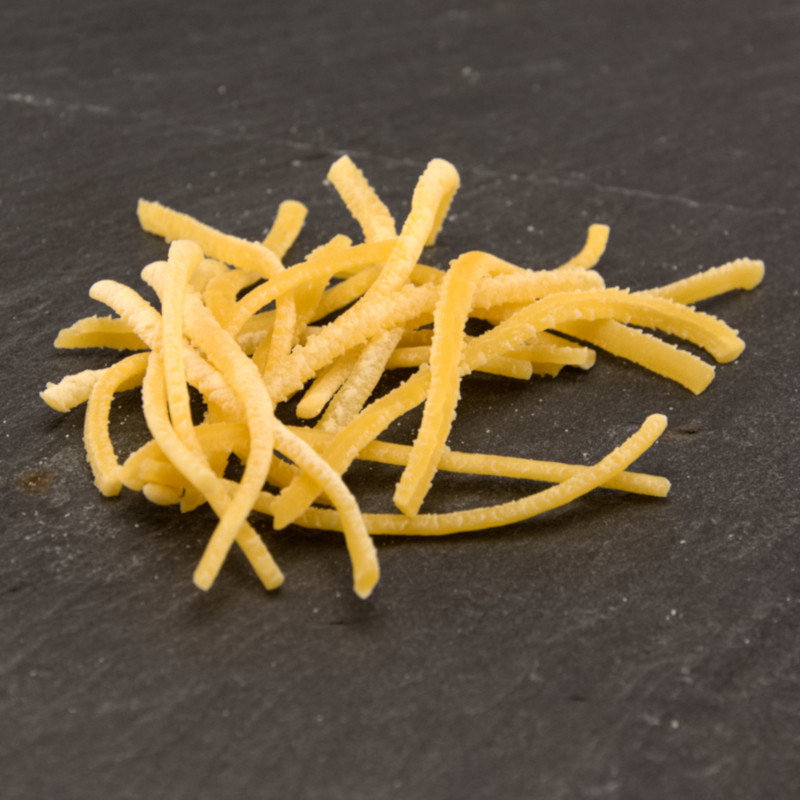Original price was: €71,2066,20 €Current price is: €66,20. incl. VAT plus shipping costs
VAT included
excl. Shipping Rate
Die set made of bronze Maccherone / Curvo, each smooth and with stripes (4 formats) 2 matrices - 4 pasta formats: How can that work? With this die set you receive two two-part dies with which you can produce 4 formats depending on the combination you choose. Maccherone liscio (macaroni with a smooth surface) Maccherone rigato (macaroni with stripes on the surface) Curvo liscio (croissants with a smooth surface) Curvo rigato (croissants with stripes on the surface). With top part 1 you specify that the pasta has a smooth surface (the top part says "liscio", the Italian word for smooth). With top part 2 you get pasta with fine grooves (the top part says "Rigato", the Italian word for striped). Bottom part 1, on the other hand, ensures that macaroni comes out (you can't mix them up, this bottom part says macaroni). If you use bottom part 2 (it says Curvo on the bottom part) you get croissants. Maccheroni (in Switzerland they are more commonly known as magronen) are tube pasta that are slightly larger than bucatini and usually a touch smaller than ziti. Depending on the region, they are sometimes eaten whole long or cut short. You have to be careful not to mix them up. Because the pasta that is mostly sold as maccheroni in Germany is a little smaller than this one. This means that anyone looking for German maccheroni will find what they are looking for in a die called “Bucatini”. Curvo: A “curvo” is a curve. Now we are not on the highway, but in this case the maccheroni makes a curve and thus becomes a croissant 🙂 Pasta insert for Kenwood AT910, AX910, KAX910ME, PP510, KAX92.AO, KAX91.A0ME. With an adapter, the die can be used in many other pasta machines, e.g. Philips Pastamaker Avance, Philips Viva, KitchenAid, Simac, Ariete, Unold, La Fattorina, Firmar, TR50, Häussler, Korngold, Omega. The die is delivered together with a transparent transport protection box. Why bronze: Bronze dies were the traditional way of making pasta. The pasta made “al bronzo” can only be found rarely and usually only in selected delicatessens. By pressing the pasta dough through the bronze matrices, the surface of the pasta is slightly roughened at the same time, making the pasta easier to grip. This allows the pasta to better absorb the sauce, flavors and spices later on. Would you like to learn more about bronze matrices? Then we recommend this article to you here. Recipe: It is recommended to use durum wheat semolina, enough cold liquid such as water and/or egg. The dough should be kneaded for about 8-10 minutes, this is the only way the gluten from the durum wheat can fully develop. The result should be a moist, crumbly dough. You can find a standard recipe for our matrices here. The matrices can also be used to produce gluten-free pasta. Sustainability: The format of the Pastidea matrices was originally designed for the Kenwood Pastafresca. By using reducing rings, the bronze matrices can be used on almost all other common pasta machines. All you need is an adapter that fits the machine. This means that even if over time the pasta machine is replaced by a different model due to a defect or for other reasons: the bronze die remains and can continue to be used in the future. Storage: Do you have several bronze matrices and are you looking for storage to protect the matrix from dust and darkening due to the effects of light? Then we recommend our storage systems, which you can also find in our range. Please note: Please note that the matrices may have small dark spots due to the material and production. This is due to the material and does not affect the function in any way. The matrices are not dishwasher safe. Should be dried immediately after cleaning to avoid water stains.
Original price was: €71,2062,90 €Current price is: €62,90. incl. VAT plus shipping costs
VAT included
excl. Shipping Rate
Bronze die set Canestrino Liscio / Canestrino rigato / Rigatone / smooth tube pasta 2 matrices - 4 pasta formats: How can that work? With this die set you get two two-part dies with which you can produce 4 formats depending on the combination you choose. Canestrino liscio (Canestrino with a smooth surface) Canestrino rigato (Canestrino with stripes on the surface) Rigatone tube pasta smooth With top part 1 you specify that the pasta has a smooth surface (on the top part it says "liscio", the Italian word for smooth) . With top part 2 you get pasta with fine grooves (the top part says "Rigato", the Italian word for striped). Bottom part 1, on the other hand, ensures that Canestrini, these are the small cups with a curve, come out (you can't confuse them, this bottom part says Canestrino). If you use lower part 2 (it says Rigatone on the lower part) you get Rigatone or the smooth version. A canestrino is a small basket. This die is similar to the Canestro, just a little smaller. This size makes it ideal for pasta salad. Or as a side dish or a complete pasta dish. Although the canestrino is a tube pasta, it can be dried easily (provided the drying conditions are right). Rigatone is a pasta that comes from southern Italy. In shape it is a tube pasta, larger than Maccheroni, smaller than Pacheri and very similar in shape to Tortiglioni. The name Rigatone comes from Riga. Riga are stripes or lines. So an allusion to the grooves on the surface, which run like lines on the surface. The -one at the end means that it is one of the larger noodles. Pasta insert for Kenwood AT910, AX910, KAX910ME, PP510, KAX92.AO, KAX91.A0ME. With an adapter, the die can be used in many other pasta machines, e.g. Philips Pastamaker Avance, Philips Viva, KitchenAid, Simac, Ariete, Unold, La Fattorina, Firmar, TR50, Häussler, Korngold, Omega. The die is delivered together with a transparent transport protection box. Why bronze: Bronze dies were the traditional way of making pasta. The pasta made “al bronzo” can only be found rarely and usually only in selected delicatessens. By pressing the pasta dough through the bronze matrices, the surface of the pasta is slightly roughened at the same time, making the pasta easier to grip. This allows the pasta to better absorb the sauce, flavors and spices later on. Would you like to learn more about bronze matrices? Then we recommend this article to you here. Recipe: It is recommended to use durum wheat semolina, enough cold liquid such as water and/or egg. The dough should be kneaded for about 8-10 minutes, this is the only way the gluten from the durum wheat can fully develop. The result should be a moist, crumbly dough. You can find a standard recipe for our matrices here. The matrices can also be used to produce gluten-free pasta. Sustainability: The format of the Pastidea matrices was originally designed for the Kenwood Pastafresca. By using reducing rings, the bronze matrices can be used on almost all other common pasta machines. All you need is an adapter that fits the machine. This means that even if over time the pasta machine is replaced by a different model due to a defect or for other reasons: the bronze die remains and can continue to be used in the future. Storage: Do you have several bronze matrices and are you looking for storage to protect the matrix from dust and darkening due to the effects of light? Then we recommend our storage systems, which you can also find in our range. Please note: Please note that the matrices may have small dark spots due to the material and production. This is due to the material and does not affect the function in any way. The matrices are not dishwasher safe. Should be dried immediately after cleaning to avoid water stains.
41,90 € incl. VAT plus shipping costs
VAT included
excl. Shipping Rate
Bronze adapter Adapter diameter: 56 mm Adapter for the following professional pasta machines: Fimar Lilly PF15E La Fattorina Fimar MPF 1.5 Arcobaleno AEX-10 Bartscher GGM-Gastro NMF5 How does it work? Simply place the bronze die with a diameter of 4,5 cm in the adapter ring and the bronze die can be used in your pasta machine. Recipe: It is recommended to use durum wheat semolina, enough cold liquid such as water and/or egg. The dough should be kneaded for about 8-10 minutes, this is the only way the gluten from the durum wheat can fully develop. The result should be a moist, crumbly dough. You can find a standard recipe for our matrices here. The matrices can also be used to produce gluten-free pasta. Storage: Do you have several bronze matrices and are looking for storage to protect the matrix from dust and darkening caused by light? Then we recommend our storage systems to you here .
Original price was: €119,9089,90 €Current price is: €89,90. incl. VAT plus shipping costs
VAT included
excl. Shipping Rate
Bronze matrix Casarecce, translates as “the homemade ones”, originally from Sicily, but can also be found in central and southern Italy. Harmonize wonderfully with Ragu or any other sauce. Casarecce bronze die. Size: 8 mm Thickness: 1,1 mm Diameter die: 70 mm Pasta insert for the following professional pasta machines: TR70 Sela TR70 La Pastaia TR70 Avancini TR70 Korngold TR70 Omegaone TR70 No adapter or similar is required. The die fits directly into the above-mentioned pasta machines. Why bronze: Bronze dies were the traditional way of making pasta. The pasta made “al bronzo” can only be found rarely and usually only in selected delicatessens. By pressing the pasta dough through the bronze matrices, the surface of the pasta is slightly roughened at the same time, making the pasta easier to grip. This allows the pasta to better absorb the sauce, flavors and spices later on. Would you like to learn more about bronze matrices? Then we recommend this article to you here. Recipe: It is recommended to use durum wheat semolina, enough cold liquid such as water and/or egg. The dough should be kneaded for about 8-10 minutes, this is the only way the gluten from the durum wheat can fully develop. The result should be a moist, crumbly dough. You can find a standard recipe for our matrices here. The matrices can also be used to produce gluten-free pasta. Storage: Do you have several bronze matrices and are looking for storage to protect the matrix from dust and darkening caused by light? Then we recommend our storage systems to you here .
Original price was: €119,9089,90 €Current price is: €89,90. incl. VAT plus shipping costs
VAT included
excl. Shipping Rate
Bronze Funghi / Trottole die 10 mm “Funghi” means nothing other than “mushrooms”. In Germany they are also known as Hütchennudeln, Schneckle or Trulli. In Italy you can also find them under the name Insalatonde (which is also the umbrella term for pasta salad pasta) and Cappelletti. Size: 10 mm Thickness: 1,1 mm Diameter die: 70 mm pasta insert for the following professional pasta machines: TR70 Sela TR70 La Pastaia TR70 Avancini TR70 Korngold TR70 Omegaone TR70 No adapter or similar is required. The die fits directly into the above-mentioned pasta machines. Why bronze: Bronze dies were the traditional way of making pasta. The pasta made “al bronzo” can only be found rarely and usually only in selected delicatessens. By pressing the pasta dough through the bronze matrices, the surface of the pasta is slightly roughened at the same time, making the pasta easier to grip. This allows the pasta to better absorb the sauce, flavors and spices later on. Would you like to learn more about bronze matrices? Then we recommend this article to you here. Recipe: It is recommended to use durum wheat semolina, enough cold liquid such as water and/or egg. The dough should be kneaded for about 8-10 minutes, this is the only way the gluten from the durum wheat can fully develop. The result should be a moist, crumbly dough. You can find a standard recipe for our matrices here. The matrices can also be used to produce gluten-free pasta. Storage: Do you have several bronze matrices and are looking for storage to protect the matrix from dust and darkening caused by light? Then we recommend our storage systems to you here .
40,90 € incl. VAT plus shipping costs
VAT included
excl. Shipping Rate
Bronze Pacchero Rigato die A pacchero is a typical southern Italian pasta. In terms of shape, it is ultimately a gigantic maccheroni, but still a touch smaller in diameter than a cannelloni. This pasta is particularly common in Naples. Paccheri used to be a typical poor man's food. Because they are so incredibly large, you only need a few of them to fill your plate. Paccheri comes in two versions: Rigato (with stripes) and Liscio (smooth). Diameter of die: 56 mm Pasta insert for the following professional pasta machines: La Fattorina Fimar MPF 1.5 Fimar PF15E Arcobaleno AEX-10 Bartscher GGM-Gastro NMF5 No adapter or similar is required. The die fits directly into the above-mentioned pasta machines. Why bronze: Bronze dies were the traditional way of making pasta. The pasta made “al bronzo” can only be found rarely and usually only in selected delicatessens. By pressing the pasta dough through the bronze matrices, the surface of the pasta is slightly roughened at the same time, making the pasta easier to grip. This allows the pasta to better absorb the sauce, flavors and spices later on. Would you like to learn more about bronze matrices? Then we recommend this article to you here. Recipe: It is recommended to use durum wheat semolina, enough cold liquid such as water and/or egg. The dough should be kneaded for about 8-10 minutes, this is the only way the gluten from the durum wheat can fully develop. The result should be a moist, crumbly dough. You can find a standard recipe for our matrices here. The matrices can also be used to produce gluten-free pasta. Storage: Do you have several bronze matrices and are looking for storage to protect the matrix from dust and darkening caused by light? Then we recommend our storage systems to you here .
40,90 € incl. VAT plus shipping costs
VAT included
excl. Shipping Rate
Bronze Sedanino Rigato die Diameter of die: 56 mm Pasta insert for the following professional pasta machines: La Fattorina Fimar MPF 1.5 Fimar PF15E Arcobaleno AEX-10 Bartscher GGM-Gastro NMF5 No adapter or similar is required. The die fits directly into the above-mentioned pasta machines. Why bronze: Bronze dies were the traditional way of making pasta. The pasta made “al bronzo” can only be found rarely and usually only in selected delicatessens. By pressing the pasta dough through the bronze matrices, the surface of the pasta is slightly roughened at the same time, making the pasta easier to grip. This allows the pasta to better absorb the sauce, flavors and spices later on. Would you like to learn more about bronze matrices? Then we recommend this article to you here. Recipe: It is recommended to use durum wheat semolina, enough cold liquid such as water and/or egg. The dough should be kneaded for about 8-10 minutes, this is the only way the gluten from the durum wheat can fully develop. The result should be a moist, crumbly dough. You can find a standard recipe for our matrices here. The matrices can also be used to produce gluten-free pasta. Storage: Do you have several bronze matrices and are looking for storage to protect the matrix from dust and darkening caused by light? Then we recommend our storage systems to you here .
40,90 € incl. VAT plus shipping costs
VAT included
excl. Shipping Rate
Bronze Quadrifoglio die The four-leaf clover – a well-known symbol of good luck. Perfect as a souvenir at the beginning of the year or to give yourself a dose of luck. Size: 39 mm Thickness: 1,2 mm Diameter die: 56 mm Pasta insert for the following professional pasta machines: La Fattorina Fimar MPF 1.5 Fimar PF15E Arcobaleno AEX-10 Bartscher GGM-Gastro NMF5 No adapter or similar is required. The die fits directly into the above-mentioned pasta machines. Why bronze: Bronze dies were the traditional way of making pasta. The pasta made “al bronzo” can only be found rarely and usually only in selected delicatessens. By pressing the pasta dough through the bronze matrices, the surface of the pasta is slightly roughened at the same time, making the pasta easier to grip. This allows the pasta to better absorb the sauce, flavors and spices later on. Would you like to learn more about bronze matrices? Then we recommend this article to you here. Recipe: It is recommended to use durum wheat semolina, enough cold liquid such as water and/or egg. The dough should be kneaded for about 8-10 minutes, this is the only way the gluten from the durum wheat can fully develop. The result should be a moist, crumbly dough. You can find a standard recipe for our matrices here. The matrices can also be used to produce gluten-free pasta. Storage: Do you have several bronze matrices and are looking for storage to protect the matrix from dust and darkening caused by light? Then we recommend our storage systems to you here .
40,90 € incl. VAT plus shipping costs
VAT included
excl. Shipping Rate
Bronze matrix Casarecce, translates as “the homemade ones”, originally from Sicily, but can also be found in central and southern Italy. Harmonize wonderfully with Ragu or any other sauce. Casarecce bronze die. Diameter of die: 56 mm Pasta insert for the following professional pasta machines: La Fattorina Fimar MPF 1.5 Fimar PF15E Arcobaleno AEX-10 Bartscher GGM-Gastro NMF5 No adapter or similar is required. The die fits directly into the above-mentioned pasta machines. Why bronze: Bronze dies were the traditional way of making pasta. The pasta made “al bronzo” can only be found rarely and usually only in selected delicatessens. By pressing the pasta dough through the bronze matrices, the surface of the pasta is slightly roughened at the same time, making the pasta easier to grip. This allows the pasta to better absorb the sauce, flavors and spices later on. Would you like to learn more about bronze matrices? Then we recommend this article to you here. Recipe: It is recommended to use durum wheat semolina, enough cold liquid such as water and/or egg. The dough should be kneaded for about 8-10 minutes, this is the only way the gluten from the durum wheat can fully develop. The result should be a moist, crumbly dough. You can find a standard recipe for our matrices here. The matrices can also be used to produce gluten-free pasta. Storage: Do you have several bronze matrices and are looking for storage to protect the matrix from dust and darkening caused by light? Then we recommend our storage systems to you here .
40,90 € incl. VAT plus shipping costs
VAT included
excl. Shipping Rate
Bronze die Gnoccho Napoletano small This pasta use for pasta production is gnocchi/nocken/nockerl from the Campania region with the capital Naples. The shape was inspired by classic potato gnocchi. The Gnocchi napoletani are the small version (there are two larger versions), which is a real all-rounder: whether it's a pasta salad, a side dish or a main course with sauce... This pasta almost always works. This format is also easy to dry. Diameter of die: 56 mm Pasta insert for the following professional pasta machines: La Fattorina Fimar MPF 1.5 Fimar PF15E Arcobaleno AEX-10 Bartscher GGM-Gastro NMF5 No adapter or similar is required. The die fits directly into the above-mentioned pasta machines. Why bronze: Bronze dies were the traditional way of making pasta. The pasta made “al bronzo” can only be found rarely and usually only in selected delicatessens. By pressing the pasta dough through the bronze matrices, the surface of the pasta is slightly roughened at the same time, making the pasta easier to grip. This allows the pasta to better absorb the sauce, flavors and spices later on. Would you like to learn more about bronze matrices? Then we recommend this article to you here. Recipe: It is recommended to use durum wheat semolina, enough cold liquid such as water and/or egg. The dough should be kneaded for about 8-10 minutes, this is the only way the gluten from the durum wheat can fully develop. The result should be a moist, crumbly dough. You can find a standard recipe for our matrices here. The matrices can also be used to produce gluten-free pasta. Storage: Do you have several bronze matrices and are looking for storage to protect the matrix from dust and darkening caused by light? Then we recommend our storage systems to you here .
40,90 € incl. VAT plus shipping costs
VAT included
excl. Shipping Rate
Bronze fettuccine die Diameter of die: 56 mm Pasta insert for the following professional pasta machines: La Fattorina Fimar MPF 1.5 Fimar PF15E Arcobaleno AEX-10 Bartscher GGM-Gastro NMF5 No adapter or similar is required. The die fits directly into the above-mentioned pasta machines. Why bronze: Bronze dies were the traditional way of making pasta. The pasta made “al bronzo” can only be found rarely and usually only in selected delicatessens. By pressing the pasta dough through the bronze matrices, the surface of the pasta is slightly roughened at the same time, making the pasta easier to grip. This allows the pasta to better absorb the sauce, flavors and spices later on. Would you like to learn more about bronze matrices? Then we recommend this article to you here. Recipe: It is recommended to use durum wheat semolina, enough cold liquid such as water and/or egg. The dough should be kneaded for about 8-10 minutes, this is the only way the gluten from the durum wheat can fully develop. The result should be a moist, crumbly dough. You can find a standard recipe for our matrices here. The matrices can also be used to produce gluten-free pasta. Storage: Do you have several bronze matrices and are looking for storage to protect the matrix from dust and darkening caused by light? Then we recommend our storage systems to you here .
40,90 € incl. VAT plus shipping costs
VAT included
excl. Shipping Rate
Bronze Linguine / Trenette / Bavette die 3,6 mm Linguine comes from the Italian word “lingua”, meaning tongue. Linguine are therefore small tongues. With a little imagination, these spaghetti-like noodles resemble long chameleon tongues. The term “linguine” comes from southern Italy, Campania with its capital Naples. In Liguria (in the north of Italy) this type of pasta is found under the names Trenette or Bavette. There they are mainly eaten with the well-known green Pesto alla Genovese or with mussels. Linguine are usually no wider than 4 mm. Ours from Pastidea are only 3,6 mm wide and therefore particularly delicate. Thanks to the fine milling, they do not fray as easily when pressed as some other linguine made from dies with larger openings. Diameter of die: 56 mm Pasta insert for the following professional pasta machines: La Fattorina Fimar MPF 1.5 Fimar PF15E Arcobaleno AEX-10 Bartscher GGM-Gastro NMF5 No adapter or similar is required. The die fits directly into the above-mentioned pasta machines. Why bronze: Bronze dies were the traditional way of making pasta. The pasta made “al bronzo” can only be found rarely and usually only in selected delicatessens. By pressing the pasta dough through the bronze matrices, the surface of the pasta is slightly roughened at the same time, making the pasta easier to grip. This allows the pasta to better absorb the sauce, flavors and spices later on. Would you like to learn more about bronze matrices? Then we recommend this article to you here. Recipe: It is recommended to use durum wheat semolina, enough cold liquid such as water and/or egg. The dough should be kneaded for about 8-10 minutes, this is the only way the gluten from the durum wheat can fully develop. The result should be a moist, crumbly dough. You can find a standard recipe for our matrices here. The matrices can also be used to produce gluten-free pasta. Storage: Do you have several bronze matrices and are looking for storage to protect the matrix from dust and darkening caused by light? Then we recommend our storage systems to you here .


